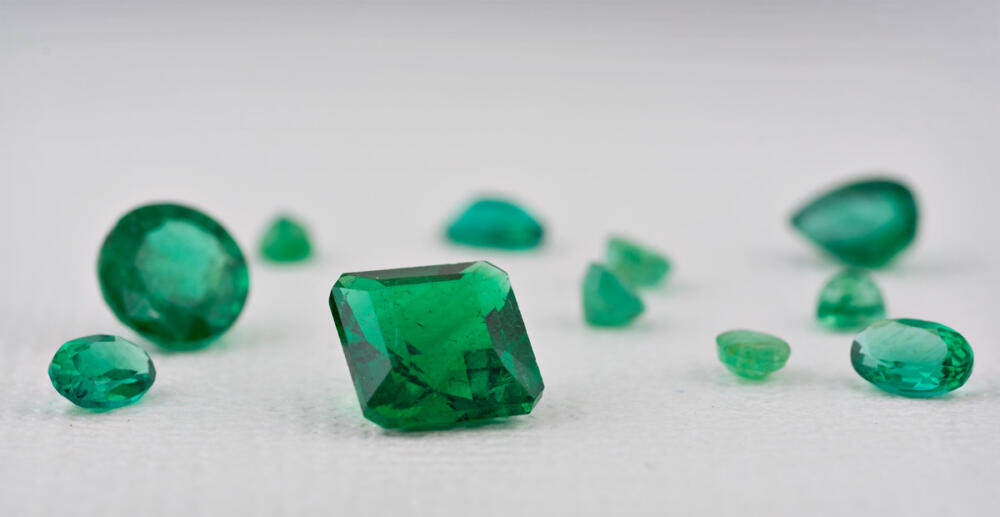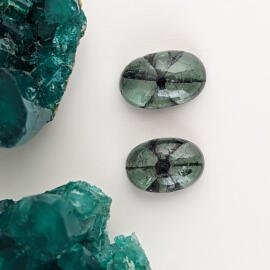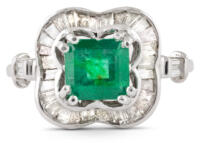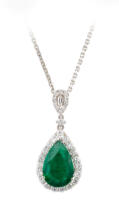Gem in the Spotlight: Emerald
Life, Love, and New Beginnings
Springtime exudes life, full of bright colors and renewed energy. Emerald, May’s gemstone, captures this enthusiasm for life in rich elegance. This precious gemstone has been revered for over 4,000 years and is associated with love, fertility, and rebirth.
Gemology of Emerald
Emeralds are a member of the beryl mineral family (along with morganite and aquamarine) and are valued for their rich green color. The intensity of an emerald’s hue depends on the presence of chromium and vanadium in the crystal structure. Emerald’s Mohs hardness rating is 7.5-8 making it softer than sapphire and harder than amethyst and other quartz varieties. The refractive index of emerald ranges from 1.57 to 1.58, making it a moderately refractive gemstone. Its specific gravity ranges from 2.65 to 2.75.
One of the distinctive features of emeralds is that they often contain inclusions. Sometimes these inclusions are referred to as jardin (the French word for garden) because they look like moss or a garden inside of the stone. These inclusions are tiny fissures, bubbles, or crystals that are visible to the naked eye. These inclusions are not necessarily considered flaws but rather add character and uniqueness to the stone.
At this point in history, almost every emerald has had some level of treatment to make the fractures less visible. It is so common that if the stone doesn’t have a report from a reputable lab (like GIA) saying otherwise, it is assumed that it has been treated with some level of fracture filling. If you do come across an emerald that has a reputable gem report that says it hasn’t been fracture filled, you have come across something extremely rare! Current estimates say that less than 1% of emeralds are untreated.
Fracture filling is a treatment to the stone that makes the fractures less visible. There are many ways to do this with oiling, natural resin, synthetic resin, silicone, and epoxy being the most. The basic technique involves submerging the stone in the desired liquid (oil, resin, etc.) inside of a vacuum chamber. Then a vacuum is applied which pulls all of the air out of the cracks and draws the filler into place. Finally, pressure is released back into the chamber and the filler is cured (some cure in ovens and some cure from UV light exposure).
History and Lore of Emerald
Emeralds have been revered for thousands of years and have been associated with many different cultures and traditions. In ancient Egypt, emeralds were believed to symbolize fertility and rebirth and were often buried with pharaohs. In Roman mythology, the stone was dedicated to Venus and likewise became a symbol of the reproductive forces of nature.
Modern science has shown us that the human eye is more sensitive to green than to any other color thereby making it easier on the eyes. Pliny said that emeralds were the only gemstones that delighted the eye without fatiguing it. In fact, Emperor Nero was said to wear a kind of emerald glasses to watch the gladiatorial games in ancient Rome (possibly one of the earliest forms of sunglasses ever recorded).
Emerald was used in the Middle Ages to foretell the future and was thought to ward off evil sorcery and cure demonic possession. The emerald was also thought to have the mystical ability to improve memory and enhance persuasiveness. Emerald amulets were worn to prevent epilepsy, avoid panic, and stop bleeding.
Emeralds also have a strong association with Christianity. In the Bible, emerald is listed as one of the twelve stones that adorned the breastplate of Aaron, Moses’ brother. Emerald was also believed to symbolize resurrection and was used in the Christian tradition to represent Christ’s victory over death.
Cleopatra treasured her emeralds more than all other gems. Pliny declared that “nothing greens greener” than emeralds. The Moguls of India, including Shah Jahan, the builder of the Taj Mahal, loved emeralds so much that they inscribed them with sacred text and wore them as talismans.
Notable Emeralds
Trapiche emeralds are one of the most rare and highly sought-after types of emeralds in the world. Their name originated from traditional grinding wheels used for milling sugarcane in Colombia, where these unique gems are predominantly found. What sets trapiche emeralds apart from other emeralds is their unique growth habit, featuring six black spokes radiating from a hexagonal core. This distinctive pattern is believed to form due to interruptions in the crystal growth process, allowing impurities such as black carbon to infiltrate the structure in a hexagonal pattern, characteristic of emerald’s crystal structure.
Hollywood celebrities have had a fondness for emeralds for many years. Elizabeth Taylor received a 23.46 carat emerald and diamond pendant/brooch from her future husband Richard Burton during the shooting of Cleopatra. She wore the emerald on her wedding day and it was later sold at Christies in 2011 for $6.6 million, setting the record for the most expensive emerald jewelry ever sold at auction.
The Chalk Emerald is a famous 37.8 carat emerald known for its clarity and rich green color. It was donated to the Smithsonian by Mr. and Mrs. O. Roy Chalk in 1972 and can be seen on display at the National Museum of Natural History in a platinum and gold ring surrounded by 60 pear-shaped diamonds. According to workers at the Muzo mine in Columbia, it is one of the finest green emeralds ever discovered
Care and Cleaning of Emerald
Like all precious gemstones, emeralds require proper care to maintain their brilliance and value. Emeralds are relatively durable, but they can be susceptible to damage from heat, chemicals, and extreme temperature changes. It is essential to store emerald jewelry away from direct sunlight and avoid exposing them to household chemicals such as bleach and cleaning agents. Emeralds can be cleaned with a soft cloth and warm, soapy water.
As we discussed above, most emeralds are fracture filled. So, you should never use ultrasonic or steam cleaners because they can permanently damage the filler material.
Despite being a relatively hard stone (with a Mohs hardness of 7.5-8), emeralds can be easier to chip than similar gems due to their plentiful inclusions. This doesn’t mean that you shouldn’t wear and enjoy your emerald jewelry. Just treat it with a little extra care, and it will shine for generations.
Why Emerald?
Emeralds are a gemstone steeped in history, superstition, and lore. Their rich green color and unique inclusions make them a stunning addition to any jewelry collection. Emerald’s beauty is so appreciated that inclusions that would make other gems nothing more than rocks are treated with distinction. If you would like to learn more about this amazing stone, or if you are looking for a great piece of emerald jewelry to add to your collection, we would love to help. Feel free to contact us, and one of our gemologists will be happy to help.





